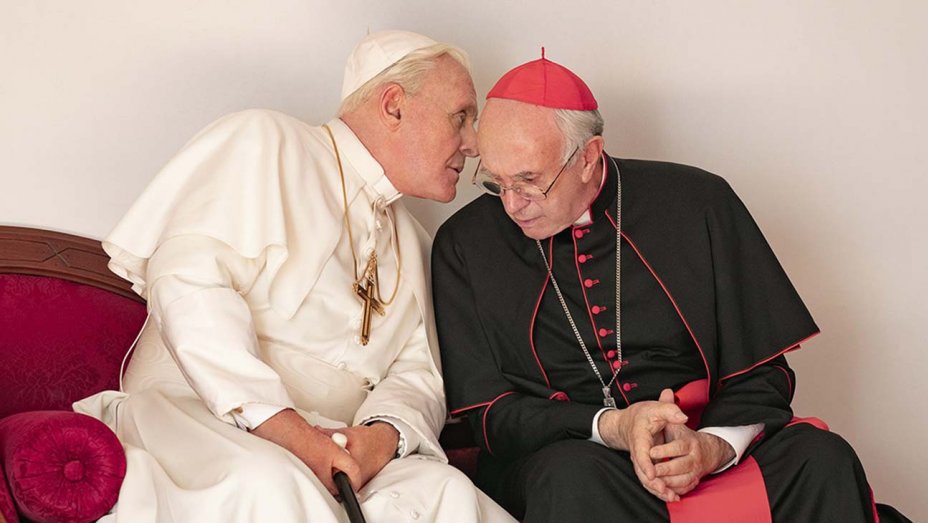THE TWO POPES is a congenial movie that ought to be an incendiary one. Set in a moment of tectonic transformation for the Catholic Church, it uses a 2012ish visit by the cardinal who would become Pope Francis (Jonathan Pryce, twinkling) to the papal residence of Pope Benedict XVI (a lurchingly immobilized Anthony Hopkins) as an exercise in conflict resolution–of a conflict that in the real world remains very much alive.
For years, the Catholic Church has been in the grip of a culture war that makes Trump vs. Pelosi seem like a buddy movie. When Pope Benedict XVI resigned his papacy in 2013 and was succeeded by current pope Francis, a rigidly dogmatic ideology enshrined under the long and iconic reign of John Paul II was replaced by a liberal left approach steeped in the neo-Marxist Theology of Liberation John Paul himself despised and even attempted to suppress. The upheaval between traditionalists and modernists has been a constant in official Catholicism ever since.
Pope Benedict was John Paul II without the charm, and it turned out the charm mattered very much. Because for all his “happy warrior” demeanor and backslapping globetrotting, John Paul II was a rigid ideologue and authoritarian traditionalist, and behind the scenes he wielded his authority like a Mafioso. His gentle paternalistic demeanor masked an almost medieval sensibility about the role of the Church in the lives of its followers, who were expected to help Catholicism fight a rearguard action against old-fangled religious bugaboos like divorce, homosexualism, and dialectical materialism, even as Catholic lives themselves were becoming as intricately woven into a generalized cultural liberalization as any others.
When Benedict tried to enforce and even extend the fundamental authoritarianism of JPII, the Church rebelled, even as a series of scandals (including Catholicism’s ongoing sex scandals over abusive priests) weakened Benedict’s moral authority to the point of ineffectuality. Benedict’s resignation was one of those “earth shattering” surprises that made total sense in an instant to those paying attention. The enormous cultural shift of the liberalizing Francis papacy that followed seem an inevitable and very belated acceptance of facts on the Catholic ground, including the importance of Latin American Catholics (Francis is Argentine) in an era where European and American Catholics have turned from the faith in droves.
While the film is well aware of Cathlocism’s great divide, THE TWO POPES presents contemporary Catholicism’s desperate schism in the tone of a lost “Odd Couple” TV episode, with Benedict as the prissy Felix Unger stickler for Catholic protocol, and Francis as the cheery Oscar, purveyor of disorderly human slop. These are men whose followers are still flaming each other daily in the Catholic press, using arguments both populist and arcane, and with some conservatives even threatening to divide the Church rather than follow Pope Francis’ pastoral guidance. One can imagine THE TWO POPES as a robust and conflict driven theological two hander in the spirit of “A Man For All Seasons,” where real human and theological attitudes are rendered vivid and significant–as if they matter urgently, foremost in the world of the film.
Instead we get movieisms, with each pope presented with the kind of interchangeable goodness at his core that used to inform the saintly priesthoods of Spencer Tracy and Bing Crosby in “Men of Boys Town” and “Going My Way.” This does a deep disservice to Benedict–a complex figure the film seems simultaneously wary of criticizing and not to care about much at all. TWO POPES is Francis’ movie from the first frame, not just because he’s the lead character but because everything–from the grabby neo-documentary shooting style to a post-modern score that blends Abba tracks with Esquivel-like chorales–endorses his calls to simplicity and an embracing of the modern world.
The choice of CITY OF GOD filmmaker Fernando Meirelles to direct this material (based on a play by Anthony McCarten) pays dividends mostly. An agnostic at the time of shooting, Meirelles claims to have experienced a spiritual awakening during production, which is empitomized in the coherence and delicacy of scenes depicting Francis as a young man (subtly portrayed by Juan Minujin), torn between the Church and secular life.
Meirelles is particularly adept at the difficult balancing act required of him in dealing with Francis’ collaborationist tendencies during Argentina’s military dictatorship of the 1970s, maintaining sympathy for his protagonist while detailing dubious actions to a point where the audience gets to decide.
Meirelles’ virtue signaling in the film’s latter half gets to be a bit much though, with random shots of international border walls used to offer an exceptionally remote criticism of Trumpist isolationism–an issue not addressed in any meaningful sense by the movie proper. Meirelles’ intriguing decision to shoot a pomp-less Vatican works more often than not, though in some exchanges between Benedict and Francis, the artless use of available light and zoomed lenses fights the performances, too often leaving Pryce (who is awards-worthy mostly) flinching in flat close-up at Benedict’s slowly melting Bavarian austerity.
Production company Netflix seems to have done a bit of flinching too; after paying to recreate the Sistine Chapel, this movie refuses to indulge Francis’ obvious delight at the army of nudes visible in Michelangelo’s depiction of the Last Judgement with even a single close-up when the set is first introduced, which makes his humorous asides to Benedict inexplicable. Beware the Netflix bots, they are quietly enacting a policy of forced erotic sterilization on our media–one the rise of Disney+ cannot be expected to counter.

